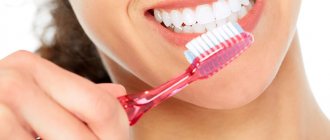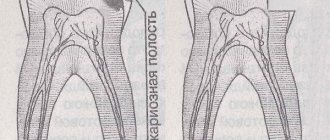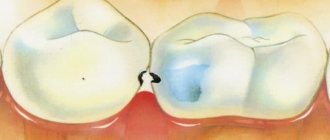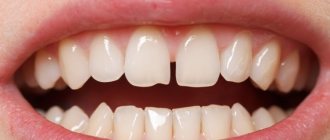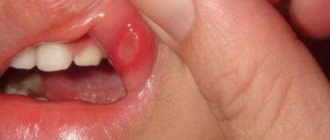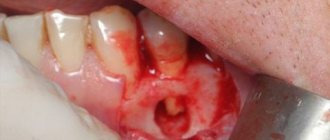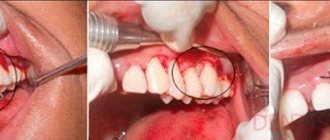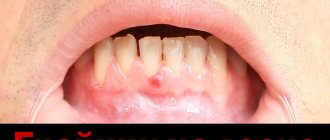What are periodontal pockets and why do they form? Symptoms and treatments
The formation of gum pockets usually occurs against the background of the development of a pathological process. In such depressions between the marginal gum and the cervical area of the teeth, plaque and hard deposits accumulate, which provokes inflammation of the mucous membrane and destruction of hard tissues. In the future, this can lead to disruption of the ligamentous apparatus, loosening and loss of teeth. Therefore, in the presence of periodontal pockets, appropriate treatment must be prescribed. You will learn further in this article about what to do if you find pockets in your gums, as well as how to treat them and how to clean them.
Advantages and disadvantages of curettage
The advantages include the following:
- Closed curettage is inexpensive: 200 rubles per pocket. Open curettage of one tooth: about 2000 rubles.
- It is possible to completely restore bone tissue (osteological preparations help with this).
- Complete elimination of gum pockets and removal of painful microorganisms from them.
- Tooth mobility completely disappears after treatment. After curettage, the teeth sit more firmly in their sockets.
Disadvantages include:
- Ineffective for periodontitis.
- Closed curettage is an expensive method.
- In terms of time, open curettage lasts quite a long time (it takes 2 hours to treat seven teeth).
- The doctor who will perform the curettage procedure must have a high category and be a specialist in his field.
- If a patient encounters an inexperienced dentist, he is likely to suffer wounds and damage to the mucous membrane.
What is a periodontal pocket - classification
To begin with, you should clearly formulate the answer to the question of what it is - a gum pocket. So, the periodontal pocket is the space between the cervical part of the tooth and the adjacent gum, which was formed as a result of detachment of the mucous membrane as a result of structural changes in the periodontium. Most often, this pathological phenomenon accompanies the development of diseases such as periodontitis and periodontal disease. The appearance of such gaps usually occurs against the background of inflammation, impaired blood supply to tissues and disruptions in metabolic processes.
Food debris gets into these cavities between the tooth and gum, where bacteria and plaque accumulate. Gradually, all these deposits harden, which further intensifies the inflammatory processes. Periodontal experts distinguish two distinct types of periodontal pockets:
- true (bone) – formed as a result of destruction of the dentofacial ligaments,
- false - appear due to swelling of the marginal mucosa under the influence of inflammatory processes. As a result, a depression is formed between the surface of the tooth and the natural groove of the swollen gums. But there is one important difference here - in this case, the mucous membrane still adheres tightly to the surface of the root on all sides.
Using a special probe, a specialist distinguishes true pockets from false ones.
To differentiate true pockets from false ones, a specialist carries out appropriate diagnostics using a special tool - a probe. It is carefully inserted into the groove between the tooth and the gum and thus determines the depth of the pocket.
Flap surgery
It is a variation of the open curettage method.
A special feature of flap surgery is the method of gum separation - a flap is formed from the damaged gum, separated from the bone tissue and removed. Further actions are similar to the open curettage method. At the end of the procedure, the mobile healthy mucosa is stretched over the free area and secured with sutures. This option is effective for periodontitis with deep periodontal pockets - up to 8 mm.
All precautions listed in other methods must be observed by the patient in this case.
Causes and factors influencing the formation of gum pockets
It is also important to consider why gum pockets form in the first place. In this regard, experts cite a number of specific reasons that most often lead to the formation of such defects:
- inflammatory pathologies of gum and periodontal tissues - advanced gingivitis, periodontitis and periodontal disease lead to structural changes in the mucous membrane, due to which it becomes swollen and loose, loses its elasticity, and becomes more susceptible to any mechanical stress,
- abundant dental deposits - plaque and tartar create a favorable environment for the active proliferation of pathogenic bacteria, the waste products of which form even more deposits, which gradually sink under the mucous membrane and lead to its inflammation,
- malocclusion - some abnormal features of the dental system significantly complicate the high-quality removal of food debris and plaque from hard-to-reach places, where deposits accumulate abundantly as a result,
- internal systemic pathologies - some diseases lead to disruption of blood supply processes in soft tissues, change the composition of saliva, which as a result contributes to faster hardening of plaque. Doctors include such diseases, for example, diabetes mellitus and other pathologies of the endocrine system, diseases of bone tissue, gastrointestinal tract, leukemia, etc.
Inflammation of the gums causes the appearance of pockets
It would be useful to highlight factors that may not directly lead to the formation of periodontal pockets, but they definitely aggravate the condition of the gums. Experts include such factors as smoking, abuse of low-quality alcohol, consumption of predominantly soft and liquid foods, incorrectly installed dentures, as well as hormonal changes, including during pregnancy, puberty and menopause.
Who's at risk
Experts in the field of periodontology identify specific factors that largely contribute to the development of inflammatory and dystrophic processes in the gums and periodontal tissues, as well as to their gradual destruction. Those at increased risk are primarily men aged 30-40 years, smokers and those who abuse alcoholic beverages1.
However, it must be recognized that today no one is immune from the appearance of periodontal pockets. Such pathological phenomena are also often diagnosed in patients during adolescence, and here the most common causes are hormonal imbalances or poor oral hygiene.
Smokers are more susceptible to the problem
Minuses
The disadvantages of this aspiration method are quite minor:
- According to statistical data from leading experts, as well as patient reviews, after curettage in the armpit area, the likelihood of relapse of hyperhidrosis remains. After 3-4 months, the nerve endings are reanimated, which can lead to increased sweating, but less pronounced than before surgery.
- Sweating cannot be eliminated 100%, so antiperspirants should be used.
- There is a possibility of various infections or bleeding, since curettage is primarily a surgical procedure.
How to determine the presence of pockets in the gums
To suspect that you have such pathological formations, you should pay attention to other accompanying symptoms. Most often, inflammatory processes in the gums are accompanied by the following manifestations:
- redness or a bluish tint; with periodontal disease, the gums usually turn pale,
- the appearance of pronounced swelling of the mucous tissues,
- unpleasant taste, including metallic, as well as bad breath - the development of halitosis,
- discomfort and pain during any mechanical impact, including during brushing teeth or eating,
- bleeding, both periodic and constant,
- gum recession and exposure of the cervical area of the teeth against the background of the formation of true pockets,
- discharge of pus from under the gums,
- general deterioration of condition, weakness, fever,
- loosening and loss of teeth.
Bleeding may be an accompanying symptom.
When contacting a periodontist with such complaints, the patient will have to undergo appropriate diagnostic measures, which, in turn, will determine the degree of neglect of the pathological process, discover the cause of its occurrence and choose the optimal treatment tactics. To do this, as part of the diagnosis, you may need to undergo radiography or rheography (study of the blood supply to tissues).
Important! Using an X-ray, a specialist will be able to diagnose moderate periodontitis. But if the pocket depth is 4 mm or more, damage to the ligaments and interdental septa will already be visible on the image. This clinical picture is also characteristic of periodontal disease.
The doctor must conduct a visual examination and instrumental examination. As noted above, a special probe is used to determine the depth of the defect. Normally, this figure should not exceed 2 mm, so the greater the depth, the more advanced the disease.
| Stage of periodontitis | Pocket depth |
| First | from 3 to 3.6 mm |
| Second | up to 5.1 mm |
| Third | up to 7 mm |
| Fourth | from 7.1 mm |
Types of curettage
In medical practice, there are three curettage methods used to remove excess sweating in the armpits.
- Aspiration or vacuum curettage of the armpits. This method of treating excessive sweating is similar to liposuction. The operation is done using a special instrument called a curette. Externally, this surgical device resembles a small spoon. On the inside of the skin of the armpits, the plastic surgeon makes a 5 mm deep incision. Through it, the process of removing excess glands, lymphatic fluid and remaining fat occurs. After surgery, nerve connections are destroyed, and the remaining sweat glands lose their ability to produce sweat.
- Laser curettage of the armpits is quite similar to aspiration, since both operations are aimed at destroying the glands. The difference lies in the use of a laser device. The duration of this operation is 20 minutes using local anesthesia.
- In terms of efficiency, the laser method is significantly inferior to the vacuum method, since it is the most lightweight. Even after 2-3 procedures, you cannot count on the effect of dry armpits. In addition, this method in some cases can cause a burn. Reviews from patients of the laser method are negative.
- The ultrasound method is similar to the laser method. The differences are that the curettage procedure is performed using an ultrasonic cannula.
Ultrasonic or laser? Which method is more effective?
Evaluating these two methods by their degree of effectiveness, we can conclude that they do not justify themselves. Ultrasound and laser procedures can destroy the sweat glands in the armpit area, but can also cause injury, as they are often accompanied by burns. Recently, leading plastic surgeons in the United States have come to the conclusion that to increase the effect, one of these operations should be combined with the aspiration method. Patients who have undergone two methods at once leave positive reviews.
What treatment is required for this clinical picture?
As for the treatment of diseases such as periodontitis and periodontal disease, an integrated approach is important to achieve stable remission. After carrying out all diagnostic procedures and making an accurate diagnosis, the doctor determines the tactics of further therapy. If necessary, prescribes appropriate procedures. For example, professional cleaning of plaque and deposits is required.
If there are already periodontal pockets, closed or open curettage is usually performed immediately. As part of complex therapy, special injections, applications with APRF membranes, a course of medications for oral administration, mouth rinses and topical application can be prescribed. If pus has already begun to ooze, antibiotics are prescribed. The following describes in more detail the main directions of complex treatment of such diseases.
Classic ultrasonic cleaning
To properly clean your pockets, you should definitely visit a dentist. You won’t be able to remove hardened deposits on your own at home. In dental clinics, this procedure involves the use of special ultrasonic devices for better and at the same time delicate removal of soft and hard deposits. Typically, ultrasonic cleaning is combined with sandblasting using an Air-Flow device, and the recesses are additionally washed using special syringes.
The photo shows ultrasonic cleaning
Gum curettage
For periodontitis, curettage is usually prescribed - this is a special procedure with which the doctor removes not only deposits, but also granulations, pus and food debris from the space between the mucous membrane and the tooth. Many people are interested in whether it is possible to cure the disease in this way, and here we need to clarify something. Unfortunately, it is impossible to completely cure pathologies such as periodontitis and periodontal disease. However, a comprehensive approach to treatment will help achieve stable remission and forget about disturbing symptoms for a long time, and prevent loosening and loss of teeth.
Closed curettage is performed without cutting or peeling off the mucosa. This procedure is usually prescribed if the depth of the defect does not exceed 3 mm. With a more serious lesion, the doctor will no longer be able to blindly clean the soft tissues from bacterial accumulations with sufficient quality, so in such cases the procedure is often performed using the open method.
The photo shows the closed curettage procedure
“I had a closed curettage done. The procedure was carried out under anesthesia, so everything went fine, I didn’t feel any pain. At first, the condition of the gums improved significantly, the bleeding, pain, and swelling went away. But honestly, after about 5-6 months, all the symptoms gradually returned. As a result, now it is necessary to perform open curettage, and this is a full-fledged operation. The doctor said that last time the pocket cleaners weren’t good enough, that’s why it’s like this.”
Timur, from correspondence on the forum www.32top.ru
Open curettage is often combined with augmentation of damaged jaw bone. For this, specialists, as a rule, use synthetic osteo-replacement chips. The procedure itself involves cutting the soft tissue and opening unhindered access to the root surface. After cleansing, it may be necessary to splint mobile teeth using fiberglass thread - according to indications.
At home, the patient will have to make oral baths for some time using antiseptic and anti-inflammatory solutions, apply appropriate topical products, and take prescribed medications, including antibiotics.
Flap operations
The effects of gum recession can be corrected with flap surgery. As part of the procedure, the doctor fills the missing area of the mucous membrane. To do this, he uses a scalpel or laser to make an incision on the mucous membrane, after which part of the tissue is removed or moved to a new location, that is, it is tightened, and then sutures are applied.
Gumplasty is one of the most effective ways to correct periodontal pockets
Drug therapy
After diagnosis and professional cleaning, the specialist will definitely give you detailed recommendations regarding home therapy. The doctor will tell you what is the best way to rinse your mouth, what toothbrushes and pastes to use, what medications to take. All this is prescribed purely individually, but there are several main vectors of drug therapy in periodontology, and here they are:
- antiseptic rinses - one of the most popular is Chlorhexidine. It and similar solutions have a pronounced antibacterial and anti-inflammatory effect,
- Antibiotics are prescribed during exacerbations of the pathological process, always if pus begins to be released. These are potent drugs that can only be taken as prescribed by a doctor.
- gels and ointments - help relieve swelling and soreness, reduce the intensity of inflammatory processes. Many of the local products have pronounced astringent properties, which promotes faster healing of affected tissues,
- multivitamin complexes - help strengthen the body and increase its protective functions, which also contributes to faster recovery.
The specialist moistens the tampon with the drug and places it in the periodontal pocket.
In the treatment of gums, it is very important to strictly follow the recommendations of a specialized specialist. You should not start taking any of the above medications without first visiting a doctor. Otherwise, you risk aggravating your condition and provoking unwanted reactions.
What can you do at home?
First of all, you should definitely contact a periodontist. You need to understand that without the participation of a specialized specialist, it will not be possible to cure the disease in any case. Self-therapy at home is acceptable only as supportive therapy, but not as the main treatment. Otherwise, you will only be able to relieve acute symptoms, but the pathological process will continue to develop in a chronic form and ultimately lead to the complete destruction of the periodontal ligaments, loosening and loss of teeth.
After consultation with a specialist, you can use decoctions and infusions prepared from medicinal plants at home. They help speed up the healing process, stop further spread of inflammation, relieve pain, itching and burning. For example, for gums it is recommended to use tinctures of eucalyptus and calendula. One teaspoon of each should be dissolved in 200 ml of warm boiled water and used as a mouth rinse 2 times a day.
Herbal decoctions can be used at home
Propolis compresses have also proven themselves to be quite effective. A decoction of chamomile has a calming effect, and oak bark has pronounced astringent properties, which promotes faster restoration of damaged tissue. And another sure-fire remedy is a soda-salt solution. Mix a teaspoon of salt and soda in a glass of warm boiled water and use for rinsing. The solution helps relieve acute inflammation and relieve pain, significantly reduce redness and swelling.
Forecast and preventive measures
The formation of true periodontal pockets indicates the onset of structural deformations in the periodontium. In an advanced stage, the pathological process leads to irreversible consequences. To minimize the risk of encountering such problems, it is important to pay increased attention to oral hygiene and promptly respond to the appearance of any suspicious symptoms.
At the first suspicious symptoms, you should consult a specialist
Remember to brush your teeth twice a day, rinse your mouth, and floss after every meal. It would be a good idea to get an irrigator for better cleaning of hard-to-reach places. Remember that the diet should contain enough fresh fruits and vegetables, when biting on them, a natural mechanical cleansing of plaque from the enamel occurs. Add more healthy foods to your food, rich in vitamins and important microelements. Try to limit your consumption of sweets, flour and carbonated drinks. And it is better, of course, to completely give up smoking and alcohol.
An important condition for proper prevention is systematic visits to the dentist for prevention. You need to visit a specialist for this purpose at least once every six months. And with the same frequency you need to undergo the procedure of the prof. hygiene – cleaning teeth from plaque and hardened deposits.
1According to WHO.


